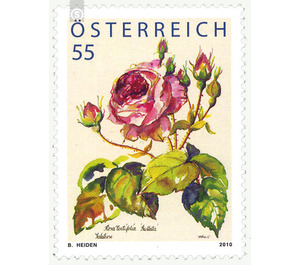flowers - Austria / II. Republic of Austria 2010 - ohne Nominale
Theme: Flora
| Country | Austria / II. Republic of Austria |
| Issue Date | 2010 |
| Face Value | 55.00 |
| Edition Issued | 200,000 |
| Printing Type | offset |
| Stamp Type | Commemorative |
| Item Type | Stamp |
| Chronological Issue Number | 2224 |
| Chronological Chapter | OOS-OE2 |
| SID | 273225 |
| In 57 Wishlists | |
The present special stamp, the loyalty gift 2010, shows a simple rose in her motif - painted by the well-known brand artist Mag. Brigitte Heiden. The delicate image of "fragrant beauty" reduces the theme of "flowers" in an equally virtuoso and aesthetic way. The rose has always been a symbol of love, joy and youthful freshness; Thus in antiquity it was dedicated to the gods Aphrodite, Eros, Dionysus, Isis and Flora; among the Teutons it was the flower of Freya. Ancient legends describe the emergence of the rose in different forms: as a remnant of the dawn on earth, as the plant that emerged from the sea foam together with Aphrodite, or that it comes from the blood of Adonis. The idea of pain was associated with the rose ("No rose without thorns") or because of its decrepit petals with transience and death. Other surviving writings show that the red color was once traced back to the blood of the nightingale, which hugged the originally white rose too violently, or to the blood of Aphrodite, who was injured by the thorns of the rose. In the spring, the Romans celebrated the "this rosae", the funeral - these Rosalia were a kind Allerseelenfest. Later, they went to the Christian Pentecost, in some Slavic peoples, they became the nature festival "Rusalija" and the female demons "Russalki". In the case of the Germans, however, the roses were associated with death; they were planted on sacrificial sites and graves. In eastern Switzerland and in the Allgäu remote cemeteries are still often referred to as rose gardens. Interesting: The white rose was in many cultures as a sign of secrecy - so white roses were hung in antique bouts, and all "sub rosa" Spoken was not allowed to leak out. In the Middle Ages, of course, the rose in the course of the Marian devotion became an important Christian symbol. The Blessed Virgin received nicknames such as "the rose without thorns" or "the most beautiful rose among women". Even in Islam, the rose is considered a sacred symbol; Saladin, after the conquest of Jerusalem in 1187, "cleansed" the dome of the rock with rose water from the Christian faith. The fact that the rose plays an important role in countless legends, legends, fairy tales, poems and songs also proves its literary significance. Sleeping Beauty, Schneeweißchen and Rosenrot and Goethe's famous "Heidenröslein" are representative of thousands of other poetic works.


